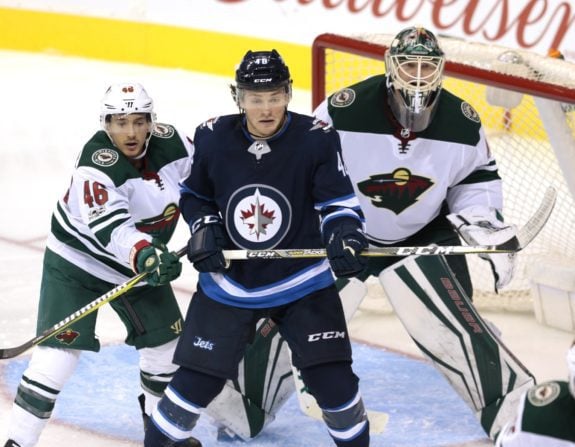Like the bang from the barrel of a gun, Jared Spurgeon’s new massive deal signals the start of the Bill Guerin era with the Minnesota Wild. Guerin got the defenseman to put pen to paper and agree to a $53 million extension as the freshly minted general manager begins to build his team.

Thankfully, there’s little doubt Spurgeon’s worth the money based on how he’s played over the last few seasons. The question is will he still be, by the time the seven-year deal comes to an end in 2027? And can the deal be justified as a result?
Spurgeon vs. Suter
The soon-to-be 30-year-old Spurgeon, who will make $5.5 million this coming season (cap hit of $5.19 million), was due for a raise. In 2018-19, he scored a career-high 14 goals and 43 points, just a few off Ryan Suter’s defense-corps-leading 47, which brings up an interesting point…
Suter co-owns the team’s highest cap hit at $7.54 million right now (with Zach Parise). Those tandem 13-year, $98 million deals were signed back in the summer of 2012 in the hopes the two would help usher in a new era of success and prosperity in the State of Hockey. It didn’t work, with the Wild arguably peaking just as the seemingly unbeatable Chicago Blackhawks did, leading to three consecutive playoff defeats at their hands.

So, if ponying up the dough failed miserably then, why now? How can Guerin pay Spurgeon even more on average than either one of his two marquee players? Several reasons, really.
Spurgeon vs. Chabot
Firstly, there’s inflation. Yeah, the yearly average annual values of Parise and Suter’s deals were seen as incredibly high, but that was seven years ago. Times have changed. If defenseman Thomas Chabot can be paid $8 million on average by the cash-strapped Ottawa Senators of all teams during his second NHL contract, which is widely being hailed as a potential steal, Spurgeon certainly can now. The only difference, other than Spurgeon’s slightly lower cap hit, is he also has a longer track record. The main issue should be whether Spurgeon can keep up the pace at age 37.

Injuries are admittedly a minor concern for a defenseman who has reached 70 games only three times in the last six seasons. However, longevity is more of a problem with regard to the Parise and Suter contracts. In fact, the Spurgeon deal, which will run out only a year after each of theirs, is conceivably a step in the right direction. By their end of each of their deals, Parise and Suter will be 40 instead.
Parise, who just led the Wild in scoring with a relatively modest 61 points, has already shown signs of statistical decline with regard to how much he’s produced in recent seasons. This past season was a nice surprise, showing he has something left in the tank, but, at age 34, it realistically can’t be much.
Meanwhile, even though Suter has proven to be a capable workhorse, his hold on the team lead in terms of ice time is dwindling (as one would expect). He used to average nearly 30 minutes per game in two of his first three seasons with the Wild. In sharp contrast, the last three seasons have seen his ice time fall below 27 minutes per game. The 26:42 he averaged in 2018-19 was the lowest amount he’s played since he was a member of the Nashville Predators and not yet the go-to guy on his own team.
Spurgeon Closes the Gap on Suter
Suter may still be the guy, but, as possibly a sign of things to come, Spurgeon’s closing the gap. In 2014-15, Jonas Brodin played 24:10 per game, which was just shy of five minutes less than Suter’s 29:04. Excluding Spurgeon, that’s the most anyone’s played directly behind Suter. This past season, Spurgeon played just 2:33 fewer minutes per game (24:09).
It’s not meant to disparage Suter fans. He’s still an integral part of the Wild, but, if the difference in ice time between Suter and the No. 2 defenseman on the team has essentially been halved over the course of the last four seasons and that No. 2 defenseman has played the same amount of time, the conclusion is undeniable: Suter is slowing down alongside Parise. It’s zeroing in on the point at which he has to start handing off the baton to the next guy, i.e., Spurgeon. There’s no good reason why it shouldn’t be him, especially if Spurgeon can be about as effective as Suter when he’s 34 and has only three years left on his deal instead of seven.
Spurgeon has seemingly spent his entire career proving people, who looked at his size and not his ability, wrong. Now it’s conceivably about the money. Listed at 5-foot-9 and 167 pounds, Spurgeon was drafted by the New York Islanders in the sixth round of the 2008 NHL Entry Draft, but failed to come to terms with them on an entry-level contract. He was a mere Wild training-camp invitee in 2010, who fit the new speedier NHL like a glove, but to become the team’s highest-paid player?

Spurgeon may not have the star power of a Parise or Suter. He’s deceivingly unassuming that way, with the skill to back up the terms of his new deal, though. If there was any legitimate doubt, the hockey world would have heard rampant criticism over his last deal, which will have paid him $20.75 million over four seasons once it ends next July.
Anyone who questions whether it’s wise to make Spurgeon the Wild’s highest earner after that point is looking at it the wrong way. Spurgeon projects as just one piece of the team Guerin will be trying to build. There are going to be other big contracts. It’s an inevitability. It’s also a marathon, not a sprint. With regard to a guy who’s made a career out of beating the odds, it’s probably a good bet Spurgeon will make it to the finish line at the end.